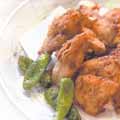|
 |
Raw Thrill THE fugu sashimi looked innocuous enough - pristine white meat without any trace of blood, arranged to resemble a chrysanthemum; quite an ethereal sight. Now being served at Nadaman restaurant in Shangri-La hotel, fugu contains the poisonous tetrodotoxin, which is 500 to 1,000 times stronger than the same amount of potassium cyanide. Toxin from one fish is said to be able to kill as many as 30 people! Not surprisingly, fugu cuisine is highly regulated by the Japanese authorities. Fugu chefs are all licensed and must train for several years to be certified. According to Nadaman's veteran fugu chef, Toshihisa Matsuura, chefs must have five to 10 years' experience before they can train as fugu chefs. In Singapore, there are only about four restaurants with licenced chefs. Matsuura, who is one of them, has been with the Nadaman restaurant chain since 1978, and since joining the Singapore branch some five years ago, has put fugu on the winter menu. (Winter is the best season for fugu as it is believed that the fish produces lower toxins then). A lot of knowledge goes into preparing fugu - from identifying the less toxic species to cleaning the whole fish. Even the disposal of the venomous parts, including liver and ovaries, is complicated. "In the past, birds would be poisoned from rummaging through garbage with disposed fugu parts," recalled Matsuura. Chefs in Japan are required by law to discard all poisonous bits into custom-made boxes with locks, which are then sent for special disposal. However, Nadaman flies in fugu meat that is already gutted and cleaned. Almost none of fugu poisonings reported, the chef assured me, stemmed from fugu prepared by licensed chefs. On that reassuring note, I popped a sliver of fugu sashimi into my mouth - and like most first-time fugu eaters, wondered what the hype was all about. It tasted rather bland but what stood out was that despite its frail, diaphanous appearance, the meat was both crunchy and chewy, a texture much sought after by fugu connoisseurs. And it can be, curiously enough, addictive. By my third slice, dipped in a piquant light ponzu sauce, I was hooked. To cut such thin slices, the chef uses a long-bladed knife, said to cost $1,000. The blade is sharp, soft and flexible. More fugu dishes followed. The chewy skin, cut into thin strips, is dipped into a lightly spicy soy sauce. Chunks of meat are dipped in a batter and fried.
When the broth is down to a few ladles in the claypot, rice is added with a raw egg cracked over, to make a light porridge - a befittingly light end to an exquisite meal. Nadaman Japanese Restaurant serves fugu dishes from now until Nov 30. The gastronomic pleasure, and thrill, comes at a price: The sashimi alone costs $108+++ while a full-course set menu comprising all items listed above is priced at $230+++. Nadaman is at Shangri-La Hotel, Orange Grove Road. For reservations, call 6213-4571. OPENING HOURS: Lunch: 11.30pm to 2.30pm; Dinner: 6.30pm to 10.30pm. UOB Dining Privileges |
 Finally,
cuts of fish are simmered in claypot, with vegetables and a clear
konbu (dried kelp) stock. The soup was suffused with delicate fugu
sweetness.
Finally,
cuts of fish are simmered in claypot, with vegetables and a clear
konbu (dried kelp) stock. The soup was suffused with delicate fugu
sweetness.